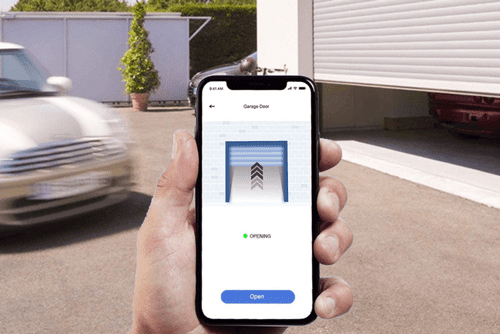Modeling and Design of a Smart Prototype Garage Door
Your garage does a lot for you. It’s a place to store your vehicles along with anything else you might need some spare space for. Not to mention, the coverage a garage offers can help you protect your items. We’ve all seen the damage something like a hail storm can cause to a car.
Over the years, garages have seen a lot of innovation with the goal of making user operation a lot easier. In “Modelling and Design of a Smart Prototype Garage Door,” the authors propose a new step in garage door automation.Importance of Automation and Garage Door Innovation
Improving automation for garage doors is a great way to make them easier to use and more widely accessible. After all, getting out of the car to open and close the door yourself is inconvenient at best. In addition, it’s not always easy or possible for someone to physically pull a garage door open and closed. So, decreasing the human effort in operating a garage door can help create greater accessibility.
Luckily, the innovation of engineers and advancements in technology lead to constantly evolving ideas. This means that new ideas about garage doors are coming out all the time – including the one these authors propose.
What Makes a Useful Garage Door Innovation?

Garage door innovations typically aim to accomplish three primary things. The first, which we’ve already gone over, is ease of use. It’s not often you see an innovation on any piece of technology that makes it harder to use. The point is to improve the experience of the consumer – you!
Another concern here is security. Given that they’re made to house expensive items like vehicles, most people don’t want to leave their garages wide open. In addition, it isn’t uncommon for a garage to serve as additional storage for other expensive items like lawn care tools. As such, making sure the owner is the only one able to grant access is crucial.
Last but not least, garage doors often boast safety features. This typically protects the owner from risk during malfunction or misoperation. For example, many modern garages feature sensors to help avoid closing anything in the garage door.

A History of Garage Door Automation
Of course, garage door automation, in general, isn’t anything new. We’ve long worked on improving things around the home – including your garage door – making for easier and quicker to operation.
For example, the authors of this design notes several other projects looking into garage door automation. One interesting concept included using an infrared motion sensor to open as someone got closer. This would work much the same way as automatic doors but in a residential setting.
Another concept used technology to recognize license plates. This way, the door opened for you as you approached, but wouldn’t open for other cars. This added an extra level of security to the concept. Other concepts included implementing a smart home system operated by a controller and other implementations of infrared technology.
What Sets This Smart Garage Door Apart?
The design proposed here offers a smart system that the owner would control using Wi-Fi and Bluetooth features. Rather than a controller, you’d control this system through a smart device like your phone.
Admittedly, this isn’t the only proposal for a smart garage door. There are a few different smart garage door options on the market today. However, not every innovation focuses on creating something brand new. Rather, some ideas improve upon an existing concept to bring a better user experience.
How Does This Smart Garage Door Prototype Work?
The authors of this paper broke the components of this system down into three categories. This includes the mechanical, electromechanical, and electric components in the operation of the garage door.
Mechanical Components in This Smart Garage Door Prototype
The mechanical components refers to a lot of the base hardware you’ll need for your garage. This includes the garage door itself and the frame it’s in. For the prototype in question, they used a simple plywood model but a workable model would fit standard garage doors.
This category also includes the rack-and-pinion mechanism used to open the garage door. In simpler terms, this looks like a gear rolling along a track slotted to fit together. This is the mechanism that moves to pull the garage door open or push it closed.
Electromechanical Components in This Smart Garage Door Prototype
This category focues on the stepper motor and the stepper motor driver. Put simply, the stepper motor is what helps power this smart garage door.
In this prototype, they found the stepper motor used didn’t provide the voltage they needed. As such, they added a motor driver to help increase output.
Electric Components

The ESP32 motor itself falls within the electric components of this smart garage door design. This is what works to power the whole system.
This section of the components also offers a variety of other details within the system. This is particularly true as it relates to operating the garage door remotely. For instance, the electric components also includes the microcontroller. This microcontroller is the piece responsible for helping your smart phone communicate with the tech in your garage.
In laymen’s terms, all of the tools in these three categories work together to offer you seamless results. Even better, that effectiveness can run right at your fingertips with just the press of an on-screen button.
What Security Measures Does This Garage Door Offer?
As we mentioned earlier, security is crucial when considering garage door design. After all, people want the chance to lock their garage the same way they do their homes.
This prototype incorporated security by using a password-protected hotspot. This is a similar concept to many smart devices in the home. It allows you to privately operate the door without someone else accessing it. Of course, the strength of the user’s password does effect how much protection this offers. It requires some thought to individual cybersecurity to take full advantage of the protection this design can offer.
What’s the Range on the Smart Garage Door Prototype
Range is another crucial element when considering a smart garage door. At the end of the day, a remote is only so helpful if it actually works from a distance. There isn’t much use in remote technology if it doesn’t actually work remotely.
This project noted two measures of Wi-Fi range. They looked at both the range out in the open and when there was obstructions in the way. This is absolutely important as if you try to open your garage from in your car, you’re surrounded by an obstruction. You need the signal to reach far enough despite this limitation.
The authors of the paper found in an open field, the signal reached about 600 meters. With the presence of barriers, the average drops to about 45 meters. Still, this is ample room to operate your garage as you get home in the evening. Plus, thanks to the consideration for the effect of barreirs on signal, you can operate without ever leaving your car.

Improvements Upon the Smart Garage Door Prototype
One of the biggest notes the authors of this paper made was that the the motor for their prototype was a bit too strong. They stated if they were to repeat the project at this scale, despite the note on voltage, the motor was simply too powerful.
The major problem with this is efficiency. When you’re creating a garage door, you want it energy efficient for a variety of reasons. For one, it’s more environmentally-friendly while saving homeowners money on energy usage as well. By using a more suitable motor, the prototype would operate with a much greater energy efficiency. At the same time, it wouldn’t take away from the operational efficiency of the system.
Does This Smart Garage Concept Have a Price Estimate?
The authors of the paper mention designing their prototype with cost in mind multiple times. However, they don’t offer an estimate of the sort of price range consumers could expect from this project. This isn’t necessarily a downfall but rather not the focus of the paper.
For reference, we can take a look at some of the products on the market today already. On average, installing a smart garage door opener today costs anywhere from $220 to $550. This estimate considers the cost of materials and labor. On the contrary, it’s an estimate for installing the opener on an existing garage door, not replacing one entirely.
Final Thoughts
All in all, this smart garage door prototype is rather promising! Although the authors noted some changes to the motor are necessary, the concept is strong. In a day and age when we use our phones so much, the option to control our garage doors from an app seems like a perfect fit.
While the idea of a smart garage door itself isn’t completely novel, it’s definitely an approach with a lot of promise. Not to mention, improvements and innovations will lead to better, more effective products for consumers.


